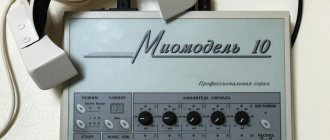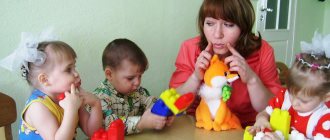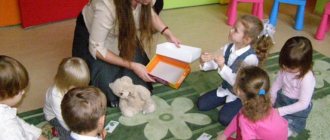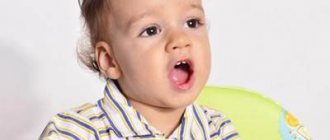Article:
Speech is the main tool for human interaction.
However, adults often forget how complex the process of oral communication is until a child appears in the family who is just learning to pronounce his first sounds and put them into words, and later into phrases and sentences. Just think about it: it takes years for a child to fully master oral speech! From birth, the child trains his tongue, vocal cords and facial muscles; his brain processes sounds coming from outside, analyzes them and issues a command for playback.
An adult bending over the cradle is touched by the first babble, and for a child this is not only the first attempts at communication, but also training. And how many words does a child need to remember! At the same time, the baby should not only be able to reproduce a combination of sounds, but also correlate them with objects, processes and phenomena around him.
Thus, a child’s speech development is a colossal work of the brain. And it should be practically completed by seven years. At the same time, speech development refers to the stages and processes associated with the child’s acquisition of oral and written speech.
Stages of speech development
Most often, the following five stages of speech development are distinguished:
- The period of preparation of verbal speech, or preparatory, or prephonemic stage , is from birth to the end of the first year of life. During this period, the child accumulates experience of interaction with the surrounding reality, on the basis of which he forms ideas about objects and phenomena of the environment that correspond to the words he is learning. The perception of the speech of adults around them contributes to the child’s gradual understanding of words. Thus, during the first period of development of the child’s speech, the child’s passive (impressive) speech activity is formed. The result of this period of speech development is the emergence of the first acts of active (expressive) speech activity - the first words independently pronounced by the child.
- The period of initial language acquisition and the formation of dissected sound speech is from the age of one year to the end of the third year of the child’s life. The need for active (expressive) speech activity is based on the development and complication of the child’s relationships with the outside world and people, and the need for verbal communication becomes one of the most important needs of the child. The development of speech activity at this stage includes the “word-sentence” stage and the stage of two-three-word sentences and is characterized by the rapid growth of the child’s active vocabulary. During the transition from the “word-sentence” stage to the stage of two- or three-word sentences, the child learns to combine words, combine them into small phrases, and further progress from the use of such phrases to the use of compound sentences occurs very quickly. The first three years of a child's life are a sensitive period for speech development . If, for one reason or another, speech in its development does not pass through the listed two periods at a given age, then in the future the process of speech acquisition is significantly hampered.
- The period of development of a child’s language in the process of speech practice and generalization of linguistic facts (stage of independent speech) covers the child’s preschool age, i.e. begins at age three and lasts until age six or seven. This period of speech development is associated with the transition from visual-effective to visual-figurative, and then to the child’s logical thinking. The main feature of this period is that the child’s speech at this time develops in the process of verbal communication, abstracted from the specific situation, which determines the need to develop and improve more complex linguistic forms. Speech reflects not only what the child already knows from his own experience, but also reveals what he does not yet know. The development of logical thinking leads to the child mastering the rules of word formation and sentence formation and independently using these rules in his speech.
- The period of a child’s mastery of written language and systematic language learning covers the child’s school age. Speech becomes the subject of special study, the vocabulary is enriched, the rules for the formation of words and sentences are studied at a conscious level. As a result, speech becomes more perfect, conscious and controlled. The most important role in this is played by the assimilation of written and detailed monologue speech.
- The period of speech improvement after completing the school period is strictly individual. With the completion of schooling, the subsequent increase in vocabulary and other speech abilities occurs to varying degrees in different people. Some people may experience a decrease in the level of speech activity.
Stages of speech development
1 month The baby begins to master the so-called sensory speech: speech hearing and concentration are formed - the baby listens when adults address him, and in response makes quiet guttural sounds “g”, “k”.
2 months Quickly responds with a smile when communicating. Screams with different intonations. Starts to walk.
3 months Listens attentively to speech addressed to him. Begins to distinguish the intonation of an adult. He hums in a sing-song voice.
4 months Humming for a long time. Answers the adult (now the baby is able to “maintain” a half-hour dialogue with his mother and other loved ones). Tries to imitate the intonations of adults.
5 months Melodiously hums for a long time with chains of sounds. Distinguishes between an affectionate tone (perks up, smiles, laughs, hums in response) and a strict one (gets scared, whines, screams).
6 months Babbles, pronounces individual syllables (“ba”, “ma”, “na”). He talks to himself for a long time. Recognizes by the voice of loved ones.
7 months To the question “where?” looks for a familiar object or toy and points at it with a finger. Babbles for a long time and actively.
8 months Begins to understand and comply with simple requests such as “give me a pen.” Tries to repeat syllables and gestures after adults.
9 months Complies with more complex requests: “kiss mom,” “bring a balloon.” Knows his name, answers the call. Attracts attention with words and gestures. Speaks with different intonations.
10 months Repeats new syllables after an adult. Pronounces the first babbling words (“ma-ma”, “pa-pa”, “ba-ba”). At the request of an adult, he shows parts of his own and someone else’s face and body: eyes, nose, ears, etc.
11 months Says “give”, “na”, etc. Understands the meaning of the word “no”.
1 year Repeats new syllables easily. He waves his head in denial and his pen in goodbye. Pronounces 6-10 lightweight words (“yum-yum”, “la-la”).
1-1.5 years Intensively replenishes his passive vocabulary. Runs errands for adults. He babbles emotionally for a long time, emphasizing the “meaning” with facial expressions, gestures, and intonation. Imitates various sounds (meows, buzzes). He says his name and shows his age on his fingers. Tries to connect two words into a sentence. At 1.5 years old, he pronounces about 30 words with simple sound composition.
1.5-2 years Understands the meaning of words and phrases, actively analyzes the speech of adults. Tries to correlate words with abstract meanings, although he often understands them in his own way. For example, he associates the word “man” only with his dad. Imitating adults, he easily pronounces familiar and unfamiliar words - both addressed to him and accidentally heard from others. Speaks in phrases. Begins to understand the grammatical structure of speech. Constructs intonationally clear interrogative and exclamatory sentences. He loves to ask questions “what is this?”, “who is this?”. At 2 years old he has an active vocabulary of 100-300 words.
2-2.5 years Speaks significantly “clearer”, speaks most of the sounds of native speech. Builds sentences quite coherently (the structure of speech approaches that of an adult, although he still uses the rules of grammar inaccurately, replacing them with his own). Actively uses new words during dialogues with adults. Asks questions “when?”, “where?”. At 2.5 years old, he has a vocabulary of 500-1000 words (at this age, boys usually lag somewhat behind girls - they use new words less actively in speech, but by 3 years they catch up with their peers).
2.5-3 years Understands almost everything that is said to him (passive vocabulary grows very quickly). Pronounces articulatory complex sounds and syllables (sometimes the correct pronunciation is combined with a fictitious one). Complements speech with rhythmic movements, gestures, and facial expressions. Constantly asks questions (including “why?” and “why?”) and easily answers those addressed to him. Uses compound and complex sentences in speech. Speaks quite fluently (can talk about the past day, but is not yet able to retell the text). He may start swearing, using swear words that he heard somewhere (do not scold the child, because this is also one of the manifestations of speech development - just explain why it is better not to say some words). At 3 years old he has a vocabulary of 2000-3000 words. The grammatical structure of speech is almost similar to the structure of adult speech.
Patterns of speech development
General patterns of human speech development come down to the following main aspects:
- The determining influence of social factors in the development of speech: a child acquires language and masters speech in the process of direct interaction with people around him and in the process of specially organized training. Speech is the main means of communication, and communication is a condition for the development of speech.
- Unity of speech development and cognitive processes : speech development is carried out together with the development of memory, attention, thinking, etc. Cognitive processes are manifested in speech and are the basis of its development. At the same time, cognitive processes themselves develop in speech activity and on its basis.
- Advancement in the development of the passive form of speech in relation to its active form : the passive form of speech is consistently ahead of the active one; The volume of speech material that children can understand is always greater than what they use in conversation.
How to quickly develop the speech of a primary school student
If your child is already a junior in school, and he still constructs sentences clumsily, finds it difficult to express his thoughts, cannot write summaries and essays, and retells them poorly, then you need to sound the alarm. But it is advisable not to force the child to do something, but to interest him.
To do this, I compiled a workbook, which in the hands of a child turns into his creation - a self-written book with stories of his own composition.
All children love to dream and fantasize. This is inherent in them by nature itself. If this talent has not yet manifested itself in a little person, then it needs to be illuminated so that it shines with all the rainbow colors.
Nowadays it is very difficult to be successful without developed speech. And every parent wants his child to stand on his own two feet and achieve a lot in life. This will largely be facilitated by confident speech, creative thinking, a flexible mind and competent writing.
The “I Can Compose” workbook activities address these challenges.
The notebook can be used both individually for creative work at home and in the classroom by a teacher.
These tasks will serve as a good help for lessons on the development of students' speech. Children will learn not only to fantasize and think figuratively, but also to construct sentences beautifully and correctly format them in writing. After these exercises, it will be much easier for children to write essays and presentations.
The notebook can be used in different ways.
This can be individual work throughout the year with periodic exchange and reading of each other's work by classmates. Children love this very much, and at the same time they are fully involved in the process and grasp the necessary skills on the fly. It is advisable to reward the most successful works with positive assessments. You can organize work in pairs or groups. Which also arouses considerable interest and brings children closer together.
As a result, each child will have a whole book written by him with interesting stories, and at the same time a developed imagination and more confident literate speech.
The workbook contains 22 tasks for composing stories on a given topic, and there are also pages for free creativity, which, if desired, you can always print out more.
As practice shows, children who have undeveloped speech also read poorly. Therefore, it is advisable to combine speech development classes with exercises to increase the quality and speed of reading. Training with specially written texts and exercises is perfect for this.
The books are written in such a way that you can study them without being a professional. That is, every parent, if desired, can become a good tutor for their child. And if you are a teacher, then these developments will be a good help in your work.
Exercises for speech development
Exercises for speech development should correspond to the stage of speech development.
- At the first and second stages of speech development, exercises to develop articulation (pronouncing sounds) are relevant, for example: how does a beetle buzz? W-w-w-w-w. How does a cow moo? Mooooo. And so on.
- At the beginning of the second stage - pronouncing words, for example: Who says “meow”? - Cat. Who says "kwa"? - Frog. And so on.
- At the second stage - making sentences based on pictures, for example: children are given pictures depicting actions (a boy does exercises; a girl has lunch; mother hangs up laundry, etc.). The child must say what is shown in the picture.
- At the third stage - compiling stories from pictures, etc.
How to develop speech in children?
Remember: developed and competent speech is the key to your child’s success. This issue needs to be approached multifacetedly, seriously and in a timely manner. This will help you:
- pure talk;
- Tongue Twisters;
- puzzles;
- charades;
- word formation games;
- rhyming exercises;
- compiling syncwines.
Follow the links. Each article provides comprehensive material that will contribute to the development of your child’s speech. Remember that without the active help of an adult, a modern child is unlikely to speak well and fluently. Therefore, develop your child’s speech and thinking.
“Developing a child’s speech together” article on speech therapy on the topic
Developing your child's speech together
All parents want their children to become highly educated, intelligent people in the future. The mental development of children is closely related to the development of their speech. Mastering a language, its grammatical structure, vocabulary, and pure sound pronunciation gives children the opportunity to freely reason, ask, draw conclusions, and reflect various connections between objects and phenomena.
However, parents do not always pay due attention to the development of their children’s speech: they either do not hear their speech defects or hear them, but do not attach serious importance to it, thinking that with age the speech defects will “disappear” by themselves. The time favorable for correcting speech defects is running out, but speech defects remain. The child goes to school, and these shortcomings bring children a lot of grief: ridicule from classmates, ungrammatical writing, comments from adults, unsatisfactory grades. The child withdraws into himself, avoids communication with peers and adults, refuses to participate in holidays, read poetry, and answers uncertainly in class.
To avoid such troubles, it is necessary to consult a specialist - a speech therapist - in a timely manner. And if a child is recommended to attend a speech therapy group, then it is necessary to follow this recommendation.
The diagnosis of “general speech underdevelopment” indicates a violation of the formation of all components of the speech system: vocabulary (dictionary), grammar and phonetics (sound pronunciation). To eliminate these speech disorders in children, speech therapy groups have been created in kindergartens. The speech therapist and educators are directly involved in the correction and development of speech in groups. But in order to achieve positive results, correct speech defects and prepare children for successful schooling, it is necessary to create conditions in the family for the general and speech development of children, with the most active help from parents.
Parents' help is mandatory and very valuable, because... It is the parental opinion that is the most authoritative for the child; only parents have the opportunity to daily consolidate the skills they are developing in the process of “live”, direct communication in everyday life with the child.
Almost all parents know that gymnastics for arms and legs is needed to make their children dexterous and strong. But not everyone knows that the tongue is the main muscle of the speech organs and gymnastics is simply necessary for it. For correct sound pronunciation, the language must be quite well developed. To prevent the occurrence of defects in the pronunciation of sounds, as well as to mitigate the severity of these shortcomings and facilitate the formation of correct sound pronunciation, it is necessary to start practicing articulatory gymnastics as early as possible. Already after 7-8 months after the birth of the baby, you can form your lips into a tube, smile, click your tongue, imitating a horse. The sooner the baby learns to click his tongue, the faster sounds that require the upper elevation of the tongue (w, g, r, l) will appear in his speech.
The time and order in which sounds appear varies from child to child. Typically, by the age of two, a child learns the sounds P, B, M, F, V, T, D, N, S, 3, L, K, G, X. Whistling (S-3), hissing (SH-SH), sonorant (R-L) at the age of 2-2.5 years, the child skips or replaces.
At this time, it is necessary to carry out preparatory work, which will help the baby master the movements of the articulatory apparatus and develop auditory attention. You can invite your child to identify a toy by onomatopoeia (dog, cow, cat, bear, etc.) or an object by its sound (tambourine, bell, drum, metallophone, etc.).
To correct defective sound pronunciation at the beginning, articulation gymnastics is carried out in front of a mirror so that the child can see the movements of the tongue. He needs this in order to see in what position the tongue is when pronouncing sounds. Gradually, articulatory skills become automated, and the need for visual control disappears.
Performing articulatory gymnastics exercises (“lips stretched out like a tube”, “stretch into a smile”, “stick out your tongue and hide behind your lower teeth”, “raise your tongue over your upper teeth”, “knock the tip of your tongue on the upper teeth, click the tip of your tongue “like a galloping horse” and many, many other exercises) you need to be patient, gentle, calm; Be sure to praise the child, stimulate motivation to practice and do not be upset if some exercises do not work out right away, repeat them with the child. Engage with your child daily for 5-7 minutes. It is best to carry out articulatory gymnastics in the form of a fairy tale (“once upon a time there lived a cheerful little tongue in his house...”).
Articulatory gymnastics is a very important part of the work to correct deficiencies in sound pronunciation, but only a part. The speech therapist, depending on the individual characteristics of the child’s speech, selects tasks to practice with him at home. Group and individual consultations are specially conducted for parents; the speech therapist explains in detail to parents how to work with their child. On the information stand we post consultations (with drawings and photos) on how to perform articulatory gymnastics. Basically, parents consolidate what was done in the group by the speech therapist and teachers. Without consolidation, the acquired skills may be lost within a few days, and then the work has to be started all over again.
In the kindergarten, all conditions have been created to ensure that children with special needs development have the opportunity to develop speech outside of classes and to stimulate the speech activity of the children themselves: a developmental speech environment has been created (speech games, various toys, sets of illustrative material, audio recordings and much more). Teachers use routine moments (dressing, hygienic and hardening procedures, walks) to activate children’s speech activity (what we put on, what it’s made of, what color; why today we dressed warmer than yesterday; how to wash our hands, face, neck; what we wash with, we wipe , what kind of soap, etc., etc.).
It is very important that parents do not miss a single opportunity to stimulate their children’s speech activity, gently and tactfully correcting those mistakes that the child may no longer make. On the way from kindergarten, ask your child about what he did in kindergarten. Find out in advance from the teacher or at the stand for parents what activities, excursions, games were on that day. Ask your child leading questions so that he remembers the past day, praise him for the drawing, the sculpted animal, for being on duty, etc.
The surrounding environment provides many topics for conversation with the child: on the way to kindergarten (street names, trees, flowers, weather, transport, rules of behavior in public places, road signs and much more). Read books to children, be sure to talk about the content, offer to retell a story or an episode you liked. Stimulate your child’s speech activity with questions, your own statements, and looking at illustrations. Activate your children’s speech at any time when the child is near you (helping in the kitchen, cleaning the apartment, while walking, etc.).
In addition to classes on developing lexical and grammatical skills, older preschoolers are taught literacy classes. And in this type of work, the interested help of parents is very necessary. The speech therapist includes this type of work in homework for children.
If parents do not remain indifferent, are interested in the successes of their children, and help them form correct, beautiful speech, then a positive result will not be long in coming.
Only close cooperation between a speech therapist, teachers and parents gives a positive result in the formation of clear sound pronunciation and the development of beautiful, grammatically correct coherent speech.
Formation of explanatory speech in preschoolers
It develops during conversations with children of the same age, solving a certain problem, and during study.
Characteristics of explanatory speech
The main features of this type of child speech are detailed sequential instructions or a set of steps for performing actions. The need to outline consecutive actions is a certain difficulty that the preschooler actively tries to overcome.
It is at such moments that most often misunderstandings arise between the speaker and the listener, which lead to conflict. Children may mishear or misunderstand each other's speech and begin to argue that the original instructions and guidelines were different.
Age norms for the formation of explanatory speech
Explanatory speech in preschool children normally begins to develop at about 3 years of age, when an understanding of functional connections and algorithms develops, and there are moments in which it is necessary to explain something or give instructions.
Important! However, this is only the beginning of the path to the development of coherent speech that answers the questions “how” and “why”. Further formation and honing of acquired skills lies on the shoulders of schoolchildren and their teachers.
How does a preschooler express himself?
Before you begin speech development exercises, you need to understand that speech itself is characterized by various features and is divided into several types according to these features.
When communicating with family and loved ones at this age, the child most often describes a specific situation or asks questions directly related to what he sees around him. The speech of a preschooler that fully describes the situation is called situational.
Preschool age
Situational speech
Situational speech is speech that a child uses in a certain situation to describe what is happening around him or to ask questions that require clarification.
The main beacon of situational speech is the replacement of the subject with a pronoun. At such moments, it can be quite difficult for adults to follow the child’s train of thought and determine what is being said. Along with the chaotic use of pronouns, the diversity of adverbs, which also do not add specificity, is also confusing. However, over time, when thinking begins to develop with renewed vigor, nouns appear instead of endless pronouns. Feeling that he is talking to an interlocutor and must convey his thoughts in a way that the other person can understand, the child after the pronoun puts the name of the object he is talking about.
Note! Thus, the outline of the story is each time interrupted by new details about the subject being described, and questions from the listener only fuel interest and the desire to tell further.
Contextual speech
New strangers and ever-growing curiosity help master contextual speech. Gradually moving from describing specific situations to abstract ones, the child learns to describe what happened to him earlier. Unlike situational speech, which is understandable only at the moment of what is happening, contextual speech is used to explain that the issues that concern him have already been resolved, and to talk about how this happened.
Moreover, it does not replace situational speech, but comes to its aid, and the further development of both types of speech occurs simultaneously.
Explanatory speech
Communication with peers in older preschool age often requires the transmission of game instructions or manipulations with toys. The speech of a preschooler containing instructions, explanations, directions is called explanatory.
Explanatory speech of a child







